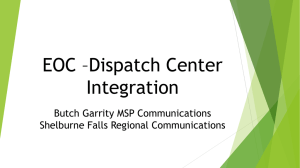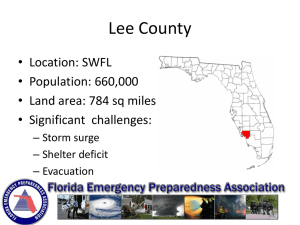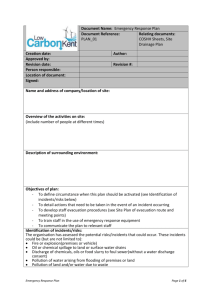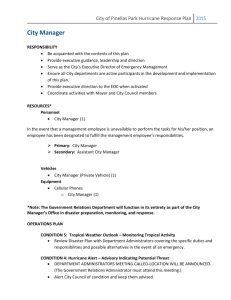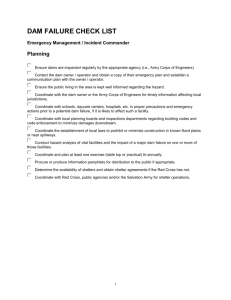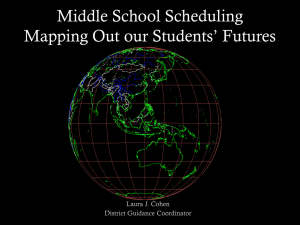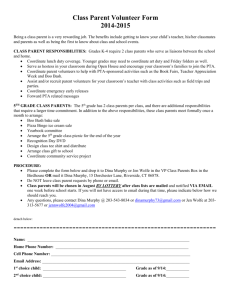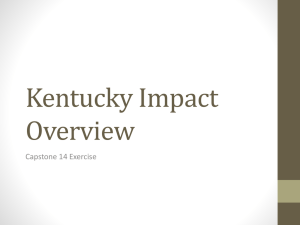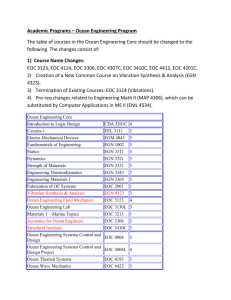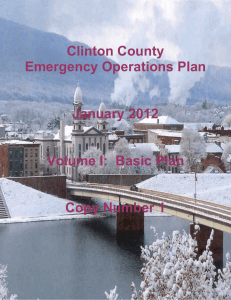Exhibit 1 - Tennessee Board of Regents
advertisement
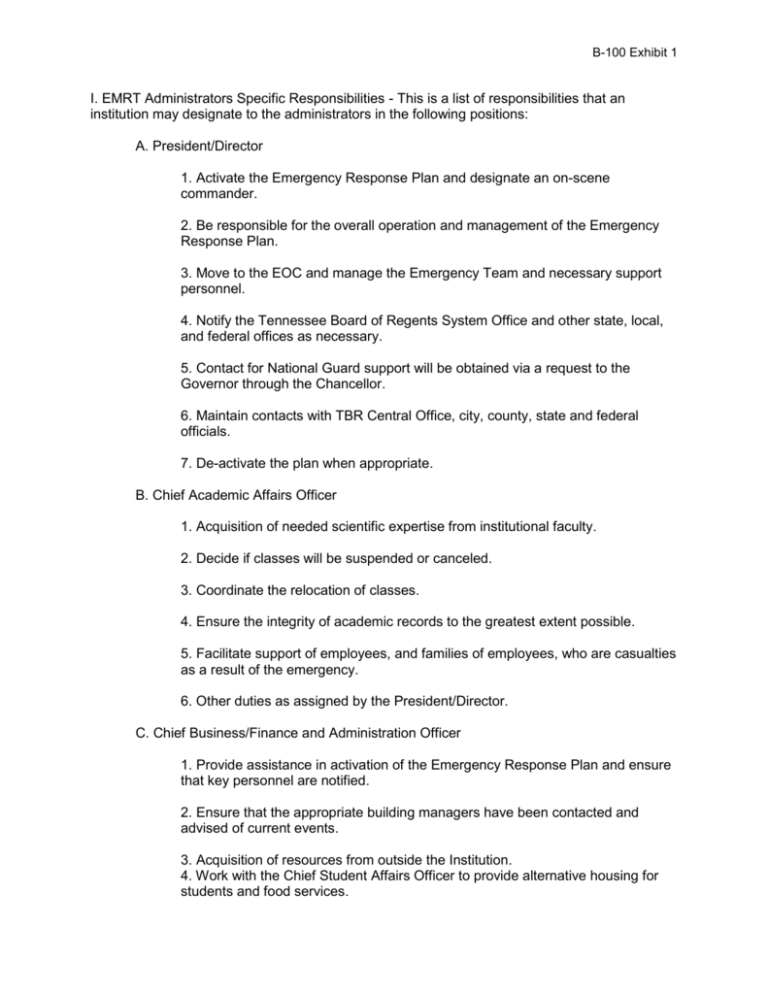
B-100 Exhibit 1 I. EMRT Administrators Specific Responsibilities - This is a list of responsibilities that an institution may designate to the administrators in the following positions: A. President/Director 1. Activate the Emergency Response Plan and designate an on-scene commander. 2. Be responsible for the overall operation and management of the Emergency Response Plan. 3. Move to the EOC and manage the Emergency Team and necessary support personnel. 4. Notify the Tennessee Board of Regents System Office and other state, local, and federal offices as necessary. 5. Contact for National Guard support will be obtained via a request to the Governor through the Chancellor. 6. Maintain contacts with TBR Central Office, city, county, state and federal officials. 7. De-activate the plan when appropriate. B. Chief Academic Affairs Officer 1. Acquisition of needed scientific expertise from institutional faculty. 2. Decide if classes will be suspended or canceled. 3. Coordinate the relocation of classes. 4. Ensure the integrity of academic records to the greatest extent possible. 5. Facilitate support of employees, and families of employees, who are casualties as a result of the emergency. 6. Other duties as assigned by the President/Director. C. Chief Business/Finance and Administration Officer 1. Provide assistance in activation of the Emergency Response Plan and ensure that key personnel are notified. 2. Ensure that the appropriate building managers have been contacted and advised of current events. 3. Acquisition of resources from outside the Institution. 4. Work with the Chief Student Affairs Officer to provide alternative housing for students and food services. B-100 Exhibit 1 5. Facilitate and track emergency related external expenditures. 6. Assist appropriate personnel in making risk assessments. 7. Coordinate the preparation of the University’s damage assessment report. D. Chief Student Affairs Officer 1. Coordinate all activities related to housing, shelters, evacuation locations, and other matters regarding institutional community members’ safety and well being. 2. Coordinate activities related to providing food services to the Institutional community. 3. Coordinate the use of existing Campus Health Clinic and Nursing Department personnel. 4. Coordinate the delivery of psychological attention to trauma victims. 5. Establish an information system for inquiries concerning the well-being of members of students. 6. Other duties as assigned by the President/Director. 7. Manage the establishment of an information system in a central location in conjunction with Information Technology and Public Relations to deal with inquiries regarding the well-being of the members of the institutional community. E. Chief Public Relations Officer 1. Establish a media staging area. 2. Schedule the time and location of media briefings. 3. Schedule media tours. 4. Prepare press releases for approval by the President / Director or TBR Central Office. 5. Keep the EMT advised of press inquiries. 6. Maintain liaison with news media sources. 7. Verify and/or issue media credentials. 8. Coordinate donations in conjunction with the Chief Advancement Officer. 9. Other duties as assigned by the President/Director. F. Chief Law Enforcement Officer B-100 Exhibit 1 1. Identify personnel for support positions in EOC. 2. Maintain a log of actions taken by EOC. 3. Maintain a log of communications to / from the EOC. 4. Maintain a log of external resources used (e.g., local law enforcement, TEMA, Red Cross etc.). 5. Be the primary liaison with the local law enforcement department / local emergency management office. 6. Make recommendations concerning areas requiring evacuations and initiate evacuations, as necessary. 7. Provide technical assistance pertaining to chemical, biological, and physical hazards. 8. Make notifications for activation and implementation of ERP. 9. Take immediate action to care for injured persons. 10. Take immediate action to reduce the threat of potential casualties and property damage. 11. Provide security of emergency area, evacuation routes, and ingress routes. 12. Survey emergency area for damages and injuries in order to request additional internal and external support required. 13. Establish a command post in the vicinity of the emergency. 14. Control criminal activity. 15. Serve as the initial commander of the command post. 16. Maintain communications with the EOC. G. Director of the Institutional Health Clinic 1. Take immediate action to care for injured persons in conjunction with law enforcement. 2. Coordinate medical response of Student Health Clinic, Nursing faculty, if necessary. 3. Establish triage area for minor injuries. 4. Coordinate with off-campus medical personnel to staff major triage areas. B-100 Exhibit 1 5. Transport medical supplies (e.g., basic first aid material, nebulizer, crutches, splints, medications, stethoscopes, blood pressure cuffs, and suture supplies) to the triage areas, if injured persons are not taken to the health clinic. H. Director of Physical Plant/Facilities 1. Render the emergency area safe from utility and physical hazards. 2. Provide vehicles and operators necessary for evacuations. 3. Provide personnel for maintenance of shelter areas. 4. Inspect buildings for signs of structural defects. 5. Exercise operational control of outside contractors and utility providers utilized to perform work on campus. 6. Provide equipment and personnel as needed for extraction of injured persons. 7. Perform clean-up responsibilities at the site of the emergency. 8. Provide personnel to assist in traffic control. 9. Serve as commander of command post when necessary. 10. Ensure that utilities are available for EOC and other essential functions. 11.Maintain communications with the EOC. I. Housing/Residence Life 1. Assist in evacuation of emergency area if residential facilities impacted. 2. Assist in controlling security of emergency area if residential facilities impacted. 3. Provide bedding for shelters and EOC. 4. Maintain storage area for property removed from emergency area. 5. Provide staff for evacuation and shelter areas. 6. Assist in determining status of students J. Information Technology/Telephone Services 1. Maintain communications and coordination with off-campus service providers. 2. Provide telephone lines and instruments required to support emergency operations.
